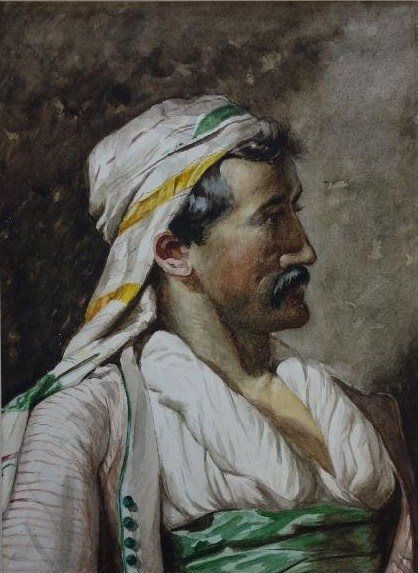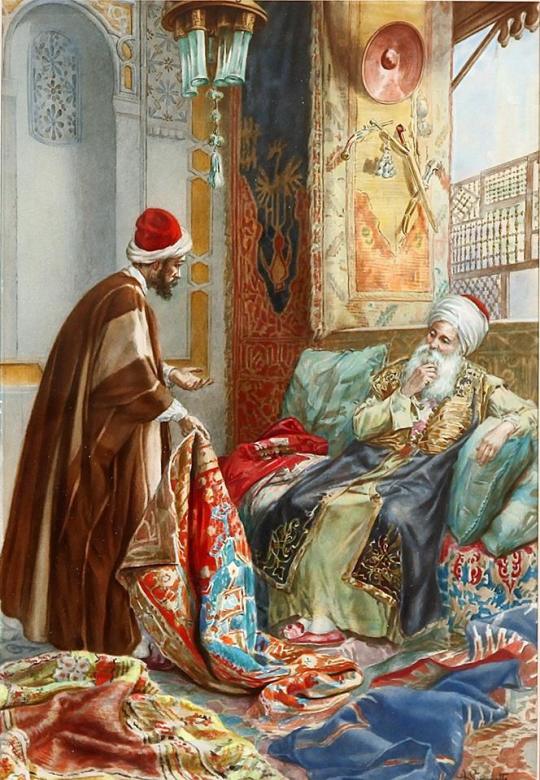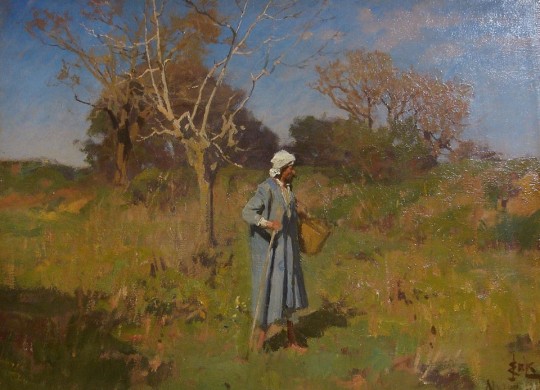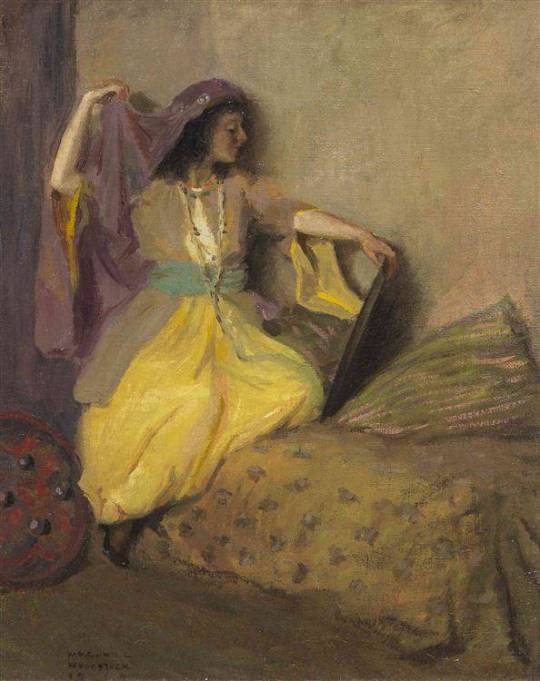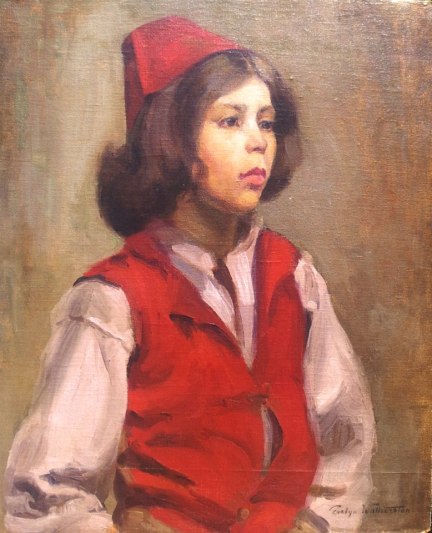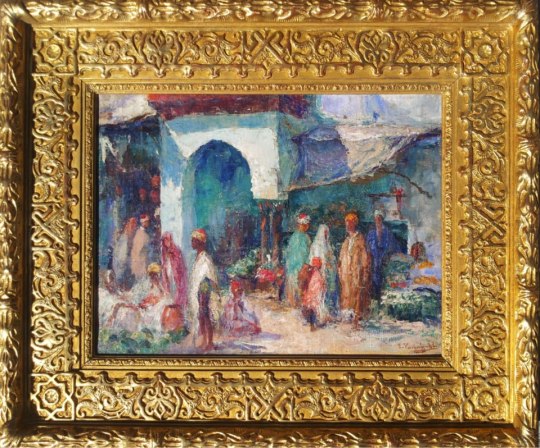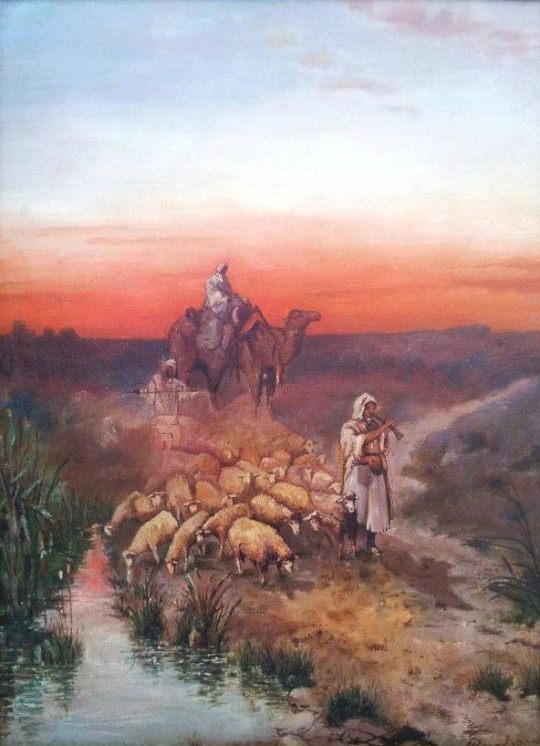
The painting of two girls by Martin Baer is oil on canvas measures 36×29 inches. It is part of the Farhat Art Museum in the orientalist collection. In the painting one can see that the older girl on the left of the composition seems that she is showing some signs of pregnancy at an early age.Martin Baer was born in Chicago on January 3, 1894. He attended the Chicago Art Institute from 1910-1914. After graduation, Martin and his brother, George officially opened the Holbein Studios, later known as the Anarchist Studios. The studio closed in 1921, and Baer went to Munich, Germany attending the Academy and studying with M. Heymann.In 1924 Baer went to Paris and met many important artists including Picasso, Soutine and Kremin. Between 1924 and 1940, Baer was based in Paris while taking extended trips to Algeria, Spain, England, Belgium and Holland. In December of 1940, Baer left for New York, and settled in Carmel, California in 1941.
In Carmel, he became one of the Directors of the Carmel Art Association, showing regularly with one-man exhibits at museums in Santa Barbara, Los Angeles and San Diego. Baer also developed a strong friendship with Edward Weston. In December 1947, Baer moved to San Francisco, opening three studios between 1947 and 1961. During this time, he developed friendships with Harry Jacobus, Hayward King, John Langley Howard and Howard Hack. Baer died February 14, 1961 in San Francisco.

His exhibition record includes Galleries Durand-Ruel (Paris 1926), Art Institute of Chicago (1926), Gallerie Jeune Peinture (Paris 1928), Galerie de la Renaissance (Paris 1932), Gallery M. Benezit (Paris 1936), Newhouse Galleries (New York 1928, 1936, 1941) His last one-man show was held at the California Palace of the Legion of Honor (San Francisco 1943). A retrospective entitled “A Memorial Exhibition of Paintings by Martin Baer” was held at the California Palace of the Legion of Honor (San Francisco 1963).

Martin Baer (1894 – 1961)
Titled :Zorah Size: 24” x 18” inches
Oil on canvas signed lower right
Titled: onthe back dated 1927 Martin Baer
Farhat Art Museum Collection.
Source:
The information is provided from Fred Vassar, Lecturer in Art History, Southern Oregon University
Note from Fred Vassar:
While the vast majority of the information in the Martin Baer biography was taken from the Memorial Exhibition held at the California Palace of the Legion of Honor, several references in the biography were in fact taken from the exhibit “Martin Baer (1894-1961) Early Drawings and Works on Paper”, put on by the Schneider Museum of Art, Ashland, Oregon 1997. These are the references to Anarchist Studios, study with M. Heymann, Picasso, being one of the Directors of the Carmel Art Association, friendship with Edward Weston and friendships it the California art community.
———————————————————————-
Martin Baer attended the School of the Art Institute of Chicago, 1910-1914; Munich
Staatsakademie, Munich, 1921-1924.
Solo Exhibitions: Gallerie M. Benezit, Paris, 1936; Newhouse Galleries, New York, 1936, 1941; The Gordon Beer Art Galleries, Detroit, 1937; Dayton Art Institute, Ohio, 1937; Norfolk Museum of Arts and Sciences, Virginia, 1937; Santa Barbara Museum of Art, 1942; Francis Taylor Galleries, Los Angeles, 1942; The Fine Arts Gallery of San Diego, 1942-1943; California Palace of the Legion of Honor, 1943, 1963; Carmel Art Association, California, 1943; North Point Gallery, Oakland, 1979; The Oakland Museum, 1979.
Public Collections: The Oakland Museum.
Literature: Thomas Albright, “Art in the San Francisco Bay Area, 1945-1980″; “The Art of California, Selected Works from the Collection of The Oakland Museum”; Susan Landauer, The San Francisco School of Abstract Expressionism.
Source:
David J Carlson, Carlson Gallery, California. Carlson’s specialty is Post-World War II California artists, and he is preparing a catalogue for a 2004 traveling exhibition of these artists to several California museums.
———————————————————————-
Note: According to “Who Was Who in American Art” by Peter Falk, the birth date of Martin Baer is reported by reputable sources as both 1895 and 1894. Edan Hughes in both editions of his book, “Artists in California, 1786-1940″ gives the date as 1894 as do the sources in the above biography and Thomas Albright in “Art in the San Francisco Bay Area”. However, Falk lists the date as 1895 because those are the dates provided when the artist was living to the publication “Who’s Who in American Art”, 1947 and 1959. (And the website of the National Gallery of Art gives the birth date as 1893).
We list 1894 as the birth date because of the number of scholars who have that date (see above), because we find only one reference to 1893, and because the birth date of Martin’s brother, George Baer, is listed as 1895 in both Hughes (first edition) and “Who Was Who” in 1940. There are no references to these brothers being twins.
This biography from the Archives of AskART
Following is text from an essay by C.J. Bulliet in a 1931 publication of the Art Institute of Chicago, Year File Archives, titled The Art of Martin Baer, George Baer.
Martin Baer was born in Chicago on January 3, 1894. He attended the Chicago Art Institute from 1910-1914. After graduation, Martin and his brother, George officially opened the Holbein Studios, later known as the Anarchist Studios. The studio closed in 1921, and Baer went to Munich, Germany attending the Academy and studying with M. Heymann.
In 1924 Baer went to Paris and met many important artists including Picasso, Soutine and Kremin. Between 1924 and 1940, Baer was based in Paris while taking extended trips to Algeria, Spain, England, Belgium and Holland. In December of 1940, Baer left for New York, and settled in Carmel, California in 1941.
In Carmel, he became one of the Directors of the Carmel Art Association, showing regularly with one-man exhibits at museums in Santa Barbara, Los Angeles and San Diego. Baer also developed a strong friendship with Edward Weston. In December 1947, Baer moved to San Francisco, opening three studios between 1947 and 1961. During this time, he developed friendships with Harry Jacobus, Hayward King, John Langley Howard and Howard Hack. Baer died February 14, 1961 in San Francisco.
His exhibition record includes Galleries Durand-Ruel (Paris 1926), Art Institute of Chicago (1926), Gallerie Jeune Peinture (Paris 1928), Galerie de la Renaissance (Paris 1932), Gallery M. Benezit (Paris 1936), Newhouse Galleries (New York 1928, 1936, 1941) His last one-man show was held at the California Palace of the Legion of Honor (San Francisco 1943). A retrospective entitled “A Memorial Exhibition of Paintings by Martin Baer” was held at the California Palace of the Legion of Honor (San Francisco 1963).
Source:
The information is provided from Fred Vassar, Lecturer in Art History, Southern Oregon University
Note from Fred Vassar:
While the vast majority of the information in the Martin Baer biography was taken from the Memorial Exhibition held at the California Palace of the Legion of Honor, several references in the biography were in fact taken from the exhibit “Martin Baer (1894-1961) Early Drawings and Works on Paper”, put on by the Schneider Museum of Art, Ashland, Oregon 1997. These are the references to Anarchist Studios, study with M. Heymann, Picasso, being one of the Directors of the Carmel Art Association, friendship with Edward Weston and friendships it the California art community.
THE BAER BROTHERS IN THE INTERNATIONAL EYE
BY C. J. BULLIET
EQUALLY AT HOME in Munich, Paris, North Africa, and their native Chicago, Martin and George Baer have attained an international outlook and ease in painting, difficult apparently, for our American artists to achieve.
Paris is the mighty maelstrom toward which the artists of all the world have gravitated for the past century. The Spaniard, Picasso, becomes as much a Parisian as the Frenchman Matisse, and so does the Italian, Modigliani, and the Dutchman, Van Gogh. The English do not readily assimilate, nor do Americans for instance, Whistler and Sargent. They participate without becoming integrally a part.
Martin and George Baer are violating the rule. Associated with the group that looked to the late Modigliani for leadership, these two Chicago young men have caught the international spirit the spirit that makes contemporary Parisian art the brilliant manifestation of world achievement.
The Baer brothers have evolved something that is recognised in France and America as distinctively “Baer.”
It is easy to trace their idols and enthusiasms Cezanne, El Greco, Cranach, and more lately, Kokoschka. Traces of them all can be discovered in their canvases.
But all such influences are offset by the “Baer” motif the something that is distinctively their own, that springs out of their inner consciousness and is readily recognizable in everything they paint.
Important galleries like the Paris establishment of Durand’Ruel and the Galerie Jeune Peinture, have thought so well of this “Baer” manifestation as to stage exhibitions of their work.
The Baers are the sons of Leopold Baer of Chicago, and it was his faith in them that enabled them to study in the best ateliers of Munich and Paris, and later plunge into the outskirts of the Sahara desert in North Africa, where they did the first series of paintings that brought them into the international eye. It was these canvases that Durand-Ruel exhibited in the spring of 1926, and that were brought later to America, and shown at the Art Institute of Chicago.
Nearly everything the brothers had painted were sold in these two shows, and with the proceeds they went back to the Sahara desert, where they did a second series, accepted by the Galerie Jeune Peinture, Paris, for exhibition in May, 1928, and later brought to America for a transcontinental tour.
The brothers found the Algerians as much to their artistic liking as Gauguin found the Tahitians. They looked upon them with a lively, leavening curiosity, and transferred them quivering to their canvases the dancing girls, swaying to barbaric music; the camel drivers, ready to start for their long journeys across the Sahara; street vendors, beggars, women of the African demi-monde, and even exalted ladies of the Moslem aristocracy. Often they had to use much tact to secure their models, owing to Mohammed’s prohibition, still respected if not always obeyed, against the portraying of the human face and body an offshoot of the old Mosaic commandment against the making of “graven images.”
The Baers had their early training in “Impressionism,” and their work in Munich was expert in the method of the reigning “academy.” It was after they went to Paris and became associated with the young group around Modigliani that they sensed the new freedom. Their German ancestry and their Munich training had given them a Germanic background which they have been wise in not wholly sacrificing in their work persists the idolatry for Cranach, and when they came only recently to see the light as manifested in Kokoschka, this German strain was found to fit.
Still in the early enthusiasm of youth, these brothers give promise of great things. Already their achievement has been notable, and it is gratifying to observe a marked improvement in the 1928 canvases over those of 1926 a loosening up of their technique, and a greater spontaneity in spirit.
The Baers are remarkable in their artistic twinship. Constantly together, they react on each other, and their painting shows twin progress. They resemble, in this respect, those literary brothers, the Goncourts.
Translated from French by Jeanne S. de LaBarthe







































